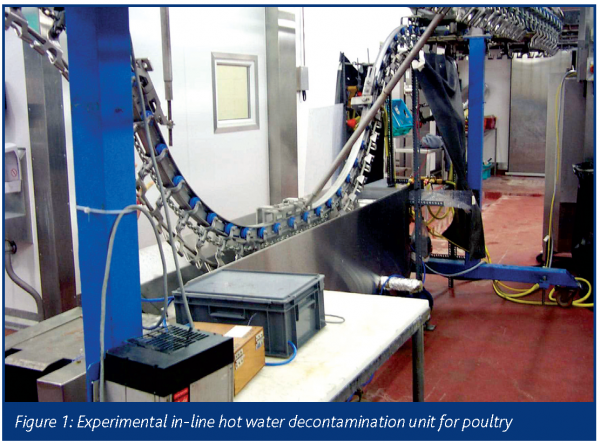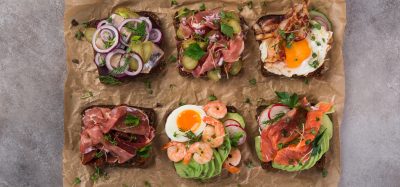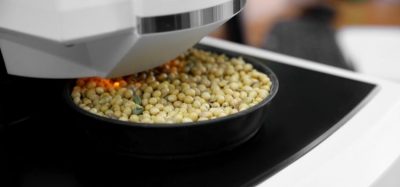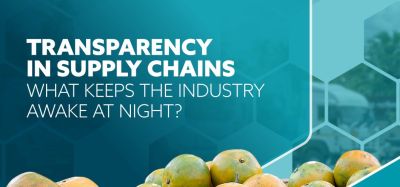Dealing with decontamination
- Like
- Digg
- Del
- Tumblr
- VKontakte
- Buffer
- Love This
- Odnoklassniki
- Meneame
- Blogger
- Amazon
- Yahoo Mail
- Gmail
- AOL
- Newsvine
- HackerNews
- Evernote
- MySpace
- Mail.ru
- Viadeo
- Line
- Comments
- Yummly
- SMS
- Viber
- Telegram
- Subscribe
- Skype
- Facebook Messenger
- Kakao
- LiveJournal
- Yammer
- Edgar
- Fintel
- Mix
- Instapaper
- Copy Link
Posted: 21 November 2005 | Christian James, Food Refrigeration Process Engineering Research Centre, University of Bristol | No comments yet
There is no terminal step (such as cooking) to eliminate pathogenic organisms from raw meat before it reaches the consumer. The consumer is relied upon to ‘adequately’ cook the meat so that any pathogens that may be present are killed. Many studies have shown that at the time of slaughter the muscle tissue of a healthy animal is, essentially, sterile and it is only the surface of the meat that is contaminated with pathogenic and spoilage organisms during slaughter and subsequent handling. This article describes the work, particularly at the University of Bristol, that is taking place to try and develop such treatments and problems that are being encountered.
There is no terminal step (such as cooking) to eliminate pathogenic organisms from raw meat before it reaches the consumer. The consumer is relied upon to ‘adequately’ cook the meat so that any pathogens that may be present are killed. Many studies have shown that at the time of slaughter the muscle tissue of a healthy animal is, essentially, sterile and it is only the surface of the meat that is contaminated with pathogenic and spoilage organisms during slaughter and subsequent handling. This article describes the work, particularly at the University of Bristol, that is taking place to try and develop such treatments and problems that are being encountered.
There is no terminal step (such as cooking) to eliminate pathogenic organisms from raw meat before it reaches the consumer. The consumer is relied upon to ‘adequately’ cook the meat so that any pathogens that may be present are killed. Many studies have shown that at the time of slaughter the muscle tissue of a healthy animal is, essentially, sterile and it is only the surface of the meat that is contaminated with pathogenic and spoilage organisms during slaughter and subsequent handling. This article describes the work, particularly at the University of Bristol, that is taking place to try and develop such treatments and problems that are being encountered.
If bacteria on the surface of raw meat could be eliminated or substantially reduced immediately after slaughter, the risk of cross contamination during processing would be substantially reduced. An efficient method of surface decontamination therefore offers substantial advantages in terms of food safety, spoilage and economics. However, the consumer would like these products to retain their ‘raw’ characteristics, so any process must not change the intrinsic nature of the food, i.e. a treated chicken carcass should still look ‘raw’.
The problems of decontaminating a carcass
Animal carcasses are not ideal shapes to decontaminate. Most decontamination treatments rely on physical contact and uniform coverage of the carcass surface, which creates difficulties as the surface of a whole animal carcass is very irregular. The outer surface of a poultry carcass, particularly, has many crevices and folds. These areas are very difficult to treat and provide protection to attached bacteria. They slow down the penetration of aqueous and gas treatments and cause shadowing problems for ‘line-of-sight’ treatments such as ultra-violet (UV) light. As well as protecting bacteria, these areas often fill with physical contamination, such as dirt and hair and do not drain well. Pools of water or chemical solutions lying in these areas can have detrimental effects on carcass appearance and cause difficulties in controlling residence times. These problems are by no means un-resolvable, but they do mean that the methods of handling and applying decontamination treatments to carcasses must be well thought out.
Methods and treatments
There is rarely any distinction made between decontamination methods and treatments. This often clouds the practical issues of decontamination. There is often too much emphasis placed on the treatment rather than the method of application. The decontamination of a meat carcass is not simply a matter of dipping or spraying the carcass with chemicals or hot water, or giving it a quick flash of light – for example, there are many factors that affect the efficiency of spray systems. In automated spray cabinets the position, number, shape and pressure of the spray all have a significant effect on the treatment, irrespective of the nature or temperature of the substance being pumped through the sprays. Many studies have shown that the method of decontamination is often more important than the treatment. There is often little significant difference between different chemical treatments when compared using the same method of application. Some studies have shown that a deluge method of application where the carcass is passed under a waterfall offers a more effective method of coverage than spraying.
Heat treatments, with or without chemicals, are very reliant on the method of application. To prevent cooking the meat, such treatments have to provide a uniform coverage to all surfaces for only a short period. In a laboratory small samples can be easily sprayed with or dipped into hot water. Steam applied to small samples can produce very high temperatures in very short times and the temperature can be subsequently reduced quickly. Using these techniques high bacterial reductions can be achieved without affecting the quality of the meat. Applying such techniques to carcasses in an abattoir, however, presents many engineering challenges.
Most decontamination treatments rely on water or chemicals to remove or destroy the microorganisms on the meat surface. However, a whole range of more novel techniques, such as microwaves, ultra-violet or visible light and ultra-sound have been suggested. Studies at the University of Bristol show that some, such as UV (Purnell & James, 2000), show more promise than others, such as microwaves (Göksoy et al., 2000).
Washing
Water sprays are the most common method of cleaning carcasses. Surface temperature and the method of applying the water are the two most important factors in bacterial removal.
Hot water is a very effective method of removing bacteria from the surface of meat, but a spray jet rapidly cools. Studies have shown that the maximum impact temperature on the carcass of a spray placed 30cm away and supplied with water at 90°C is approximately 63°C. Abattoirs have always been worried about the effect of hot water on the appearance of carcasses. However, studies have shown that treatments of 70-85°C for 5-10s not only significantly reduces bacterial levels but does so without any permanent damage to the surface tissue. Automated washing systems have long been considered the way forward and spray and deluge systems for red meat carcasses have been developed in the US and Australia. These systems have yet to be adopted by UK abattoirs where, despite wide spread use of manual washing systems during the 1970s, there is a traditional (unproven) concern that ‘wet’ carcasses spoil easily. The poultry industry, on the other hand, is less adverse to water and hot water immersion systems (Figure 1 and Figure 2) have been developed by the University of Bristol (Purnell et al., 2004) and are undergoing commercial trials in the UK funded by the Food Standards Agency.
Chemicals
Many studies have been carried out to test groups of chemicals for antimicrobial activity against specific pathogenic and food spoilage organisms. A wide range of chemicals are known that will destroy or severely limit the growth of pathogenic and spoilage bacteria. However, the number of chemicals that are likely to be approved for use on meat is severely limited – not least because of legal restrictions. One major stumbling-block to the use of chemicals has been that EU regulations have prevented their use on ‘fresh’ meat. It is likely that current changes taking place to EU regulations will remove this restriction. However it is likely that, in order to be approved as a processing aid in the EU, evidence will have to be provided that:
- No residues are left on the treated product that present a health risk
- There is no toxicological effect on the finished product
For many potentially useful chemicals there is little scientific data that has addressed this area. Independent, unbiased and industrially relevant research work is required to aid interpretation and assess the parameters governing these criteria. This will also go some way to addressing many of the meat industry concerns regarding chemicals. The EU Scientific Committee on Veterinary measures relating to Public Health (SCVPH) recently (2003) considered four chemicals (chlorine dioxide, acidified sodium chlorite, trisodium phosphate and peroxyacids) commonly used in the US for their potential in treating chicken carcasses.
Steam
Steam at 100°C has a substantially higher heat capacity than the same amount of water at that temperature. If steam is allowed to condense onto the surface of meat then it has the ability to rapidly raise the surface temperature of the meat. One very attractive feature of condensing steam is its ability to penetrate cavities and condense on any cold surface.
Steam can be produced under vacuum at temperatures substantially below 100°C without significantly reducing its heat capacity. It has been demonstrated to be an effective way of decontaminating poultry drumsticks and carcasses (Klose et al., 1971; Evans, 1999). Similar reductions have been achieved using very short treatments of steam under pressure (140°C for 50ms). Over-heating of the meat was prevented by repeated cycles of heating and cooling (Morgan et al., 1996; Kozempel et al., 2003). Studies at Bristol have demonstrated the effectiveness of this treatment on vacuum packaged beef primals (Purnell et al., 2005).
A successful steam system (Nutsch et al., 1997) has been developed and is being used in the US, mainly for treating beef sides; the FMC Steam Pasteurisation System (SPS). A number of cabinets are available, depending on the required throughput. Commercial evaluations of the SPS carried out in the UK have not proved quite as successful as American trials, principally owing to the cleanliness of UK carcasses (Eveleigh, 2000). Success has been achieved in our recent studies (Corry et al., 2003) using the same principle on chicken carcasses (Figure 2).
Future progress
To achieve any significant improvement in the microbiological condition of meat it has been assumed that a 4 log-unit reduction in total bacterial numbers is required. To date, no adequate method of achieving this has been found without affecting the sensorial quality of meat. However, in relation to Campylobacter, it has been predicted that a 2-log reduction in numbers on raw poultry would lead to a 30-fold decrease in human campylobacteriosis (Rosenquist et al., 2003). This is achievable.
In the US commercial abattoirs are utilising a wide range of decontamination treatments, often sequentially. Despite the success and commercial realisation of thermal surface decontamination systems there are still gaps in the understanding of these systems. To realise the full potential of steam surface pasteurisation it is necessary to understand the relationship between heating/cooling cycles and appearance/quality changes for foods of interest. The conditions that will maximise bacterial reduction without significant quality changes require identification in addition to engineering understanding to produce those required conditions consistently over the surface of food when presented at industrial throughputs. To this end, an EU project (BUGDEATH) coordinated by the University of Bristol has recently been carried out to investigate the effect of known temperature-time histories on the survival of bacteria on the surface of foods, as reported last year in New Food, Volume 7 Issue 2 (James, 2004). Using bespoke rigs (Figure 3) to control the temperature at the surface of a food sample this work has shown, importantly, that water activity plays a key role in the effectiveness of steam decontamination treatments. However, it has also shown that many other things are happening and that far more studies are needed before we have a complete understanding of the conditions required for success.






References
Corry, J. E., James, C., O’Neill, D., Yaman, H., Kendall, A. & Howell, M. (2003) Physical methods, readily adapted to existing commercial processing plants, for reducing numbers of campylobacters, on raw poultry. Proceedings of the 12th international Workshop on Campylobacter, Helicobacter and Related Organisms, Aarhus, Denmark, International Journal of Medical Microbiology, 293, 32.
Evans, J. A. (1999) Novel decontamination treatments for meat. In: COST Action 97 – Pathogenic Micro-organisms in Poultry and Eggs. 8. New Technology for Safe and Shelf-stable Products, ed. Ellerbroek L, Luxembourg, Office for Official Publications of the European Communities, ISBN 92-828-7442-7,14-21.
Eveleigh, K. (2000) Carcass decontamination. Meat and Poultry 2000 – Seminar 1, Campden & Chorleywood Food Research Association, UK, 17 July 2000.
Göksoy, E. O., James C. & Corry, J. E. L. (2000) The effect of short-time microwave exposures on inoculated pathogens on chicken and the shelf-life of uninoculated chicken meat. Journal of Food Engineering, 45, 153-160.
James, S. (2004) End of the road for pathogens? New Food, 2, 28-31.
Klose, A. A., Kaufman, V. F., Bayne, H. G., & Pool, M. F. (1971) Pasteurisation of poultry meat by steam under reduced pressure. Poultry Science, 50, 1156-1160.
Kozempel, M., Goldberg, N. & Craig, J. C. (2003) The vacuum/steam/vacuum process. Food Technology, 57, 30-33.
Morgan, A. I., Goldberg, N., Radewonuk, E. R. & Scullen, O. J. (1996) Surface pasteurisation of raw poultry meat by steam. Lebensmittel -Wissenschaft und -Technologie, 29, 447-451.
Nutsch, A. L., Phebus, R. K., Riemann, M. J., Schafer, D. E., Boyer, J. E., Wilson, R. C., Leising, J. D. & Kastner, C. L. (1997) Evaluation of a steam pasteurisation process in a commercial beef processing facility. Journal of Food Protection, 60, 485-492.
Purnell, G. & James S. J. (2000) UV surface decontamination of wrapped and unwrapped meat joints, poultry and lettuce. IChemE Food and Drink 2000: Processing Solutions for Innovative Products, Institution of Chemical Engineers, UK, ISBN 0 85295 438 7, 135-138.
Purnell, G., Allen, V., James, S. & Ketteringham, L. (2005) The effects of surface steam treatment on bacterial reduction and storage of beef primals and retail cuts. Journal of Food Engineering, 68, 419-427.
Purnell, G., Mattick, K. & Humphrey, T. (2004) The use of ‘hot wash’ treatments to reduce the number of pathogenic and spoilage bacteria on raw retail poultry. Journal of Food Engineering, 62, 29-36.
Rosenquist, H., Nielsen, N. L., Sommer, H. M., Nørrung, B. & Christensen, B. B. (2003) Quantitative risk assessment of human campylobacteriosis associated with thermophilic Campylobacter species in chickens. International Journal of Food Microbiology, 83, 87-103.
SCVPH (2003) Opinion of the Scientific Committee on Veterinary Measures relating to Public Health (SCVPH) on the evaluation of antimicrobial treatments for poultry carcasses. http://europa.eu.int/comm/food/fs/sc/scv/ outcome_en.html









